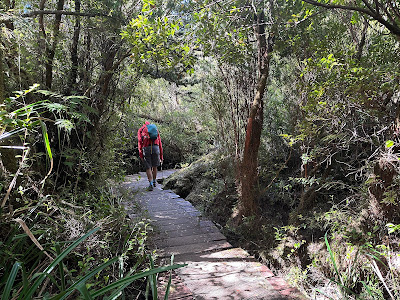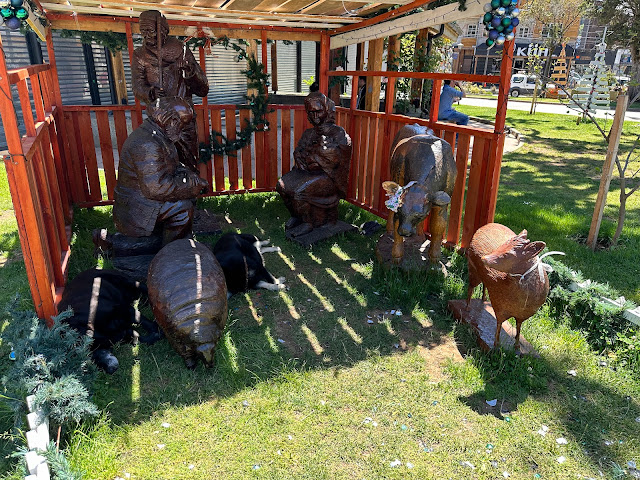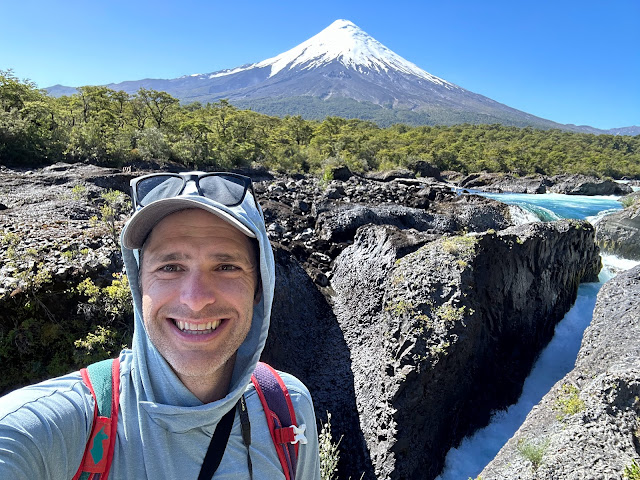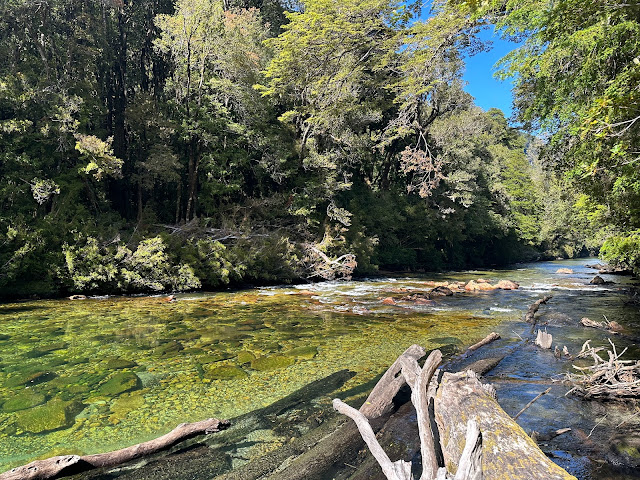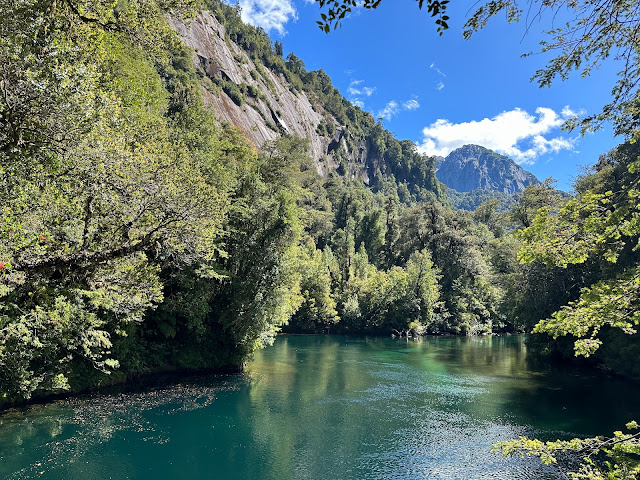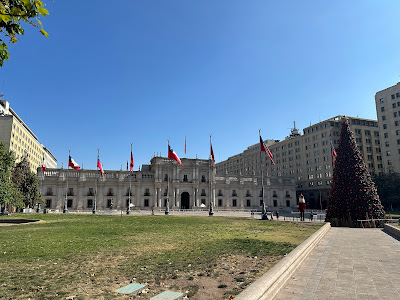We landed in Puerto Montt without any challenges, although we hit challenges not long after touching down. I had reserved a rental car for us several months ago. After collecting our bags (some relief as this was the last place they could go missing before we flew home) we made our way to the Avis rental car counter. When the gal working the counter wandered back over, we encountered the first major bump in our plans. Despite my reservation, she was telling me there were no cars available for us. Crap. Pretty much all of our plans for the next and final week of the trip hinged upon us having our own set of wheels!
The lady said she did have a potential solution for us. She steered us to a man wandering around the airport lobby with a clipboard. He described himself as working for a "local rental car company" and they would honor the same rate we had agreed to with Avis. Slightly desperate for a car, and I'm always interested in supporting local buisnesses, we decided to at least hear him out. He led us out to the curb and waved to a partner who pulled a car up in front of us. At first glance... not great.
I started negotiating with the man in my subpar spanish and his subpar english while Austin was documenting everything wrong with the car so we could indicate as such on the agreement. As I'm talking contracts, insurance, and pricing I can hear Austin: "broken tail light, scratched bumper, scratched door, cigarette burn on the driver seat cover, dora the explorer sticker on the radio, bald tires." Ok that was enough for me! Nope!
I don't know whether it was bought cheap, borrowed, or stolen but it screamed like a bad decision. I thanked the man and said we just couldn't rent this vehicle. Back in the airport, hat in hand, I started working my way down the desk line with every rental car brand. Nope, all booked, sorry. Finally West rental car said they had vehicles! I've never rented from or heard of West, but I asked to see a car and it at least had good tires and no dora the explorer. After insisting on all the insurance in case of any unforseen mishap, we had our wheels! A silver Suzuki Swift that we would grow extremely fond of. I should say, that as I walked back through the airport with our Suzuki car rental all squared away I did see someone at the Avis counter filling out paperwork for a vehicle. I don't know if they were trying to scam me, had other more expensive vehicles that they held for this man, or what, but it was not a good look for Puerto Montt's Avis.
We headed west. Puerto Montt is a proper city but everything we had heard indicated it wasn't worth spending much time in. A few kilometers out of town and we were back into the small towns and back roads we had grown accustomed to. The destination for the next couple days was the Island of Chiloe. We easily caught one of the ferries between the mainland and the island that run about every 30 minutes and finally took a deep breath. Glad to have a car and be back in control of things.
Chiloe is a large island that is covered in green pastures, pockets of rainforest, old wooden churches, and more unique wildlife. There are a handful of national parks on the island which are really just undeveloped patches of rainforest and upland scrub/bog.
After unloading off the ferry we headed towards Ancud and our hostel reservation. We also had the added complication of it being Christmas Eve in a very Catholic Country. We needed to hit a grocery store and stock up since we couldn't be confident anything will be open tomorrow or later this evening.
In Ancud we fought the grocery store crowds, found our lodging and tried to unwind. Ancud is right on the coast so we walked around that night and the next morning spotting new bird species.
Whimbrel
These are Flying Steamer Ducks (I think? They look EXTREMELY similar to Flightless Steamer Ducks). We would see both species of Steamer Ducks, I just can't promise I can always tell them apart.
That night I ended up migrating to the floor. The bed I was planning to sleep in had a steady drop of termites and wood castings from the ceiling right on to my pillows. Definitely an eventful first few hours in this part of Chile.
The next morning we headed along the coast towards a scenic section of coastline to look for Humboldt Penguins. Along the way we were keeping our eyes out for Southern Pudu, the second smallest deer in the world (just behind their slightly smaller cousins the northern Pudu). Pudu are found all throughout this northern part of Patagonia but their populations are dense on Chiloe providing our best chances of seeing them. Despite being skunked with the Huemul we were feeling confident for a Pudu sighting. The species is a point of pride for the island with "brake for Pudu" signs, Pudu crossings, and lots of Pudu named landmarks but everyone kept telling us seeing one mostly comes down to luck.
We drove towards the very small town of Punhuil and Monumento Natural Islotes de Puñihuil to look for Humboldt Penguins. Once you leave the main road on Chiloe you lose pavement quickly. Our little Suzuki Swift handled the steep bumpy gravel roads like it had something to prove. We nicknamed our plucky little car Pudu as well. Just seemed to fit the personality and kept us hopeful that we'd see the deer too.
Monumento Natural Islotes de Puñihuil was gorgeous. There's an observation point on private property, and a few pesos (even on Christmas) allowed us to climb up to the overlook.
Very different flora here than where we just came from a couple days ago. Proper temperate rainforest.
Chilean Rhubarb
We could hear penguins along the right hand shore of the island, but after close scanning decided they were more Megallanic Penguins the same species we had seen earlier. Humboldt Penguins off the coast of Chile have actually experienced a major dieoff in 2023 due to Highly Pathogenic Avian Influenza. The disease has been hitting colony nesting birds all over the world. Around 1/3 of the Humboldt Penguin population was lost in 2023 to the disease. I can't say for sure that was why we didn't see any here, but it was on my mind.
On the way back we did find some Flightless Steamer Ducks (100% sure this time) and chicks. Those tiny wings made the identification super easy.
These little ducklings kept their heads in the water and were in almost constant motion. Like little water beetles just swimming and whirling in circles.
Kelp Goose, in kelp.
I love oyster catchers. We saw Megallanics in Puerto Natales, these are Black Oyster Catchers. All Oyster Catchers have this high pitched nasaly laughing sort of call when they are flying. But Black Oyster Catchers decided the drop the laughing part and had more of a nasaly high pitched scream. The first time we heard it, it was shocking and hard to believe it came from this bird and not some sort of bad Halloween decoration.
From here we took a series of dirt roads back across the entire island to the town of Castro. It was Christmas Day so hard to really get a feel for a town when everything is closed down. We would wander back through later when things were open. The houses on the water were still a cool view.
Cheese sandwich Christmas Day lunch.
Chiloe is known for it's old churches scattered across the island.
We hopped back on our dirt roads and crossed the island again, this time headed for Chiloe National Park. We wanted to wander some of the remote corners and try hard to find some of the unique wildlife like the Pudu, Darwin's fox, and Darwin's Frog.
Chiloe National Park was a lovely mix of rainforest and wetland. It was summer and seemed like a pretty dry start to it, so much of the wetland was less "boggy" than usual. We looked for wildlife walking as much of the major trails as we could with the remaining day.
We looked really hard for Darwin's frog in particular. This is a species you hear about when you take herpetology in college because of it's unique parenting strategy. The males will guard the eggs until they become tadpoles, then scoop them all up into its mouth and carry them there until they develop into tinyfrogs and hop out. Needless to say I really wanted to see one, but new it was a long shot. I was glad to see the park and the island were as fond of the frog as I.
Despite being in a spot where one was see within the last 24hrs, we didn't find a Darwin's Frog. It was tough since the vegetation was extremely thick, this species is about the size of my thumbnail, and we were really supposed to stay on the trails. We did find some other reptiles and amphibians.
Painted Tree Iguana
I think this is the Chiloe Island Ground frog
I think this is Emilio's Ground Frog
Great Grebe, largest grebe in the world. We found this one guarding a nest.

We may have lost track of time a bit looking for wildlife and walking the trails, and probably overestimated our ability to find a place to camp for the night. By the time we got back to the car and on the road to look for camping options we were racing daylight. Camping was apparently a popular activity here on Christmas so most of the sites we found were full or expensive. We did pull into one, which like the others was someone's yard/pasture/field that the allow you to camp on. I tried to negotiate a price but space was limited and it was more than we wanted to pay naively assuming we'd find something better. Well we didn't. And when we got back to Castro it was too late to get a hostel for the night... So we found a quiet pull off on the side of the road, unpacked the sleeping bags, reclined the seats, and the Suzuki "Pudu" would be home for the night. Not a completely unsual situation for me, but maybe not what I would have preferred in a foreign country.
At one point in the middle of the night I woke up and out of the corner of my eye I saw some flashing lights. A few seconds letter all my mental alarm bells went off as someone knocked on the window. "Crap! Austin it's the cops!" I pulled my wits together and opened the window to two federal officers with flashlights. I was preparing myself to beg for forgiveness or whatever I needed to do, but they were extremely nice. They just wanted to make sure we were ok. I gave them a thumbs up and told them we ran out of options for camping. They laughed at us then went on their way.
The next morning we made two decisions, we wanted to spend another night on Chiloe to keep looking for Pudus (I wasn't about to admit defeat and not see two species of deer!) and we were going to book a hostel for the night first thing that morning.
We were heading south for Parque Tantauco. This is a super remote park at the southern end of the island. It was a bit of a gamble because we read trip reports that said the 25 or so kilometers of dirt road were pretty rough and high clearence was recommended. Well our Suzuki "Pudu" wasn't anywhere close to high clearence, but the weather had been good, we bought all the insurance for it, and it hadn't let us down yet!
It was a long slow drive that took most of the morning, but we made it. And as we were getting close to the park we saw three Pudus! A small buck, a doe, and small fawn! Collectively we saw all of them for about six seconds as we crested a hill and there they were, only to immediately run into the dense brush. They are adorable, and tiny. The buck was smaller than border collie. Well no pictures but just so happy to see them!
In Parque Tantauco we spent most of the remainder of the day exploring the trails. There were sections of super thick rainforest but adjacent to areas that have burned and not regrown. Again with the warm dry start of the summer those places felt very hot and dry.
This is a Chucau Tapaculo. They weren't shy about making their presence known, but they liked to stay in the cover and didn't come out often.
After the long dirt road back out we reached our hostel for the night just outside of Castro, avoiding the mistakes we made the night before. In Castro we found dinner and I probably had the single best tasting dish all trip. Whatever they put on these potatoes you could put on a flip-flop and I'd eat it.
The next morning we headed north. It was time to catch the ferry off the island and head inland to see some other parts of the lake district. As we were driving north on the main road across the island I spotted something brown on the edge of a clearing. I slammed on the breaks flipped the car around and went to confirm what I had hoped, a Pudu doe and fawn were foraging on the edge of the forest!
We watched them for a while before the both ducked under the bottom strand (they're so small!) of the barbed wire and disappeared in the brush. We also spotted this Plumbeous Rail on the way off the island. I'm used to rails being very secretive but this one had no concerns with us.
We drove back around Puerto Montt and then to Puerto Varas on the banks of Llago Llanquihue with the stunning Volcan Osorno in the distance. Puerto Varas looks and feels like a resort town. On the lake, casinos, upscale hotels. It did have the best nativity scene I have ever seen though.
I would like to propose that all nativity scenes include Pudus, sleeping dogs, and giant armadillos.
Outside of Puerto Varas we found a campsite along the banks of the lank in the town of Ensenada. As we were checking in I finally got more than a couple seconds look at the giant Patagonian Bumble Bee as it worked a couple of the flowers planted around the campsite. The "flying mouse" is only found in Patagonia, the largest bumble bee in the world, and culturally important in Chila. Both the campground host and I stopped what we were doing to to try and take pictures before it flew off.
After we set up camp, we hopped back in the car to go check out Parque Nacional Vicente Perez Rosales just up the road. The parks in this part of the country can be challenging. They are often large, but undeveloped. On one hand this was great undisturbed wilderness as it should be, but access outside of a few kilometers of trail is often bushwhacking or non existent. We explored the trails around the park headquarters with the last hours of the day.
Chilean Fox
Crested Caracara
I'd like to submit this to Suzuki for their next advertisment. Loved our lil car.
Banded Kingfisher back by camp.
The next day we decided to head south for the Cochamo Valley, nicknamed the Yosemite of South America. After a pleasant hour and a half drive we reached the valley trailhead. This area is quickly becoming a rock climbing destination, and probably the only reason it still hasn't really developed much is it's almost completely a cooperative of private landowners, and about a 6-7 mile hike in from the parking lot. We didn't have the time or the gear to tackle any of the climbing routes, but we wanted to see the trail, the landscape, and the valley anyway so opted for a trail run.
It wasn't long on the trail before I stopped abruptly when I heard what sounded like a woodpecker. It would of course the be the case that we finally see the fantastic Megellanic Woodpecker when neither Austin nor myself have anything but a camera phone. These are such cool and big woodpeckers, bigger than the largest woodpeckers we have back home. They always forage as family groups, as with the male and female along our trail.
The trail into the valley is extremely eroded. It's still the main access route for the private landowners and camping services in the valley so we had to dodge strings of horses on the way in and back out carrying supplies. But we were in the thick of temperate rainforest now.
Major eroded out ruts in the trail. Can a horse even make it through that?
The glimpses of the paralleling river were fantastic. Perfect clear water.
We finally made it to the base camp in the heart of the valley and quickly saw where the Yosemite comparisons come from.
We had to take a cable trolley across the river to keep moving up the trail.
We would turn around and head back after this waterfall. I'd love to return to the valley and actually climb some of the routes up those granite cliffs.
Our camp site for the last two nights.
Foxes near parking lots were starting to become a theme.
The next day would be our last before flying to Santiago and starting the long process of getting home. We had a place to sleep outside of Puerto Montt lined up and needed to get cleaned up to not upset anyone on the plane next to us. We decided to take a scenic route back to Puerto Montt and hit one more National Park and look for some of the oldest trees in the world.
We drove down to Parque Nacional Alerce Andino. This is another expansive park with only a couple of trails. We found the park headquarters and trailhead then packed up for a morning hike to find the Alerce trees. Alerce are fir trees that can be more than 3,000 years old! The park headquarters may have had the most convincing anti-wildfire sign I have ever seen.
A burning Pudu fawn is about the worst thing I've even seen.
The park trail was well maintained and wandered through dense forest. The unexpected highlight was the number of giant bumble bees. What were once seemingly rare or uncommon elsewhere were super common here. Still tough getting them to sit still though.
Delicious bugs coaxed this Chucau Tapaculo from the shadows.
After a few easy miles we made it to the first and one of the larger Alerce trees. Massive organisms that have been alive since before the time of Christ are just cool.
Knowing what to look for, we spotted many others across the high landscape and hills on our way back to the car.
I drove white knuckled for the first time through the very busy downtown of Puerto Montt, and confirmed what we had heard... those few minutes to drive through were enough time to spend in downtown Puerto Montt. We kept going to the outskirts of town and found our Air BnB for the night.
The next morning we were cleaned up, freshly laundered, and headed to the airport. We said our heart felt good boys to our Suzuki "Pudu." After the disaster with Avis rental car, I couldn't have been happier with how things worked out. A relatively quick flight had us in Santiago. Our time here was primarily a lay over on the way home. But we had the majority of the day to explore the city before our flight the next morning. Santiago is right at the transition where Chile really becomes desert. Still nestled against the Andes, but a landscape looking more like the desert southwest.
This is a popular summer drink in Chile and there were several street vendors serving it up. Called Mote con huesillo, it tasted like super sweet peach tea (the huesillo) with a dried peach and pieces of wheat berries soaking up the liquid in the bottom. I'm a fan.
Catholics go big.
Apparently Bill stopped here for a bite while in town as president.
Santiago had everything you would expect in a major large city. One day was enough time to explore and get a taste. The people were friendly and the food was great, I resisted the temptation to sample their Taco Bell. One thing we noticed that was kind of funny is there were street vendors everywhere selling yellow underwear. Yellow boxers, yellow briefs, yellow thongs, yellow lingerie. After asking the locals we were reminded that it was coming up on New Years Eve, and it's good luck to wear yellow underwear on New Year's Eve! Well the vendors in Santiago can make sure you are dressed appropriately for the holiday.
We made it to the airport the next morning and starting the long 3 leg trip home. I don't know what else to say at this point, Patagonia is stunning. Even the worst days where we slept in the car, had to scramble to get a car, eating cheese sandwiches were still full of beautiful landscapes, new wildlife, and friendly people. The biggest problem is even three weeks is not enough time. The region is huge and the real challenge is finding the time and deciding where to spend it.



.jpg)














.jpg)




































